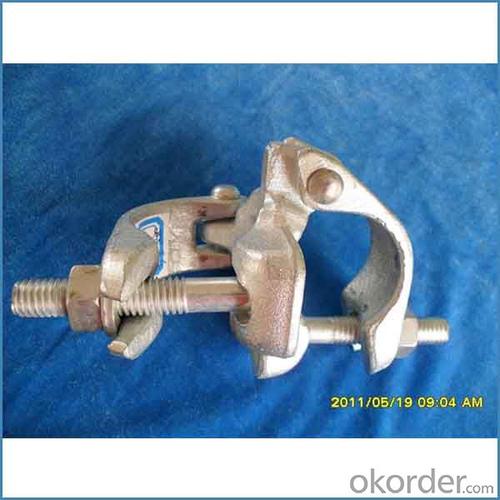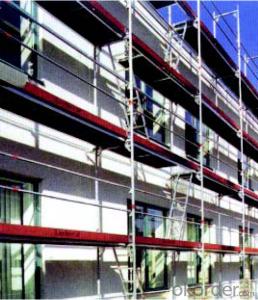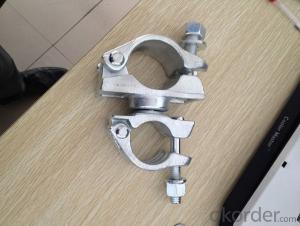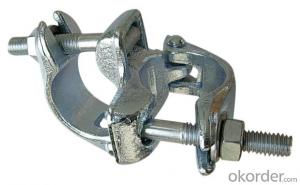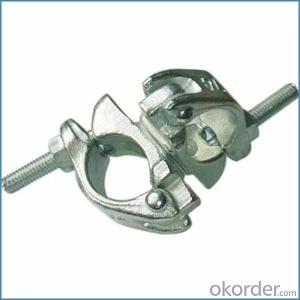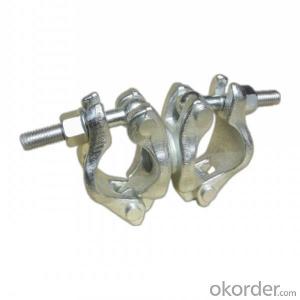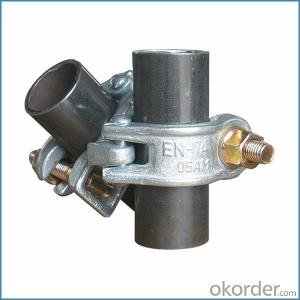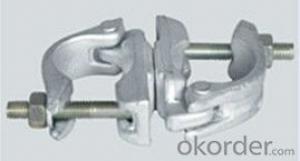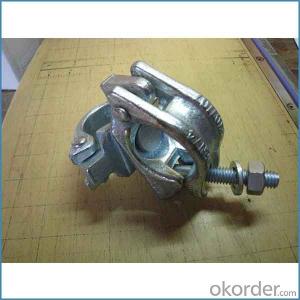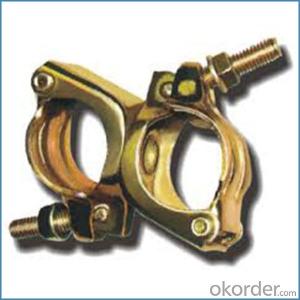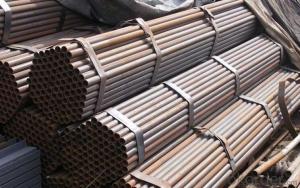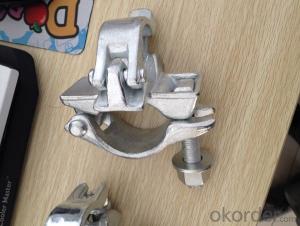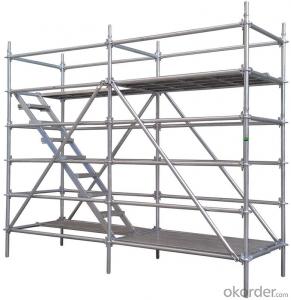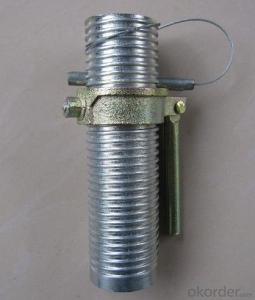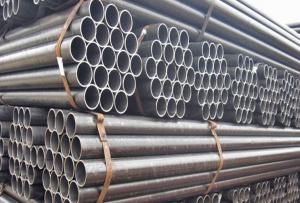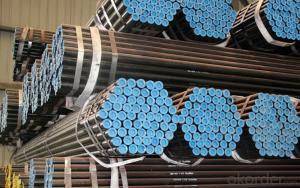Bs1139 Scaffolding Swivel Coupler British Type for Sale
- Loading Port:
- Tianjin
- Payment Terms:
- TT OR LC
- Min Order Qty:
- 100 kg
- Supply Capability:
- 100000 kg/month
OKorder Service Pledge
OKorder Financial Service
You Might Also Like
Bs1139 Scaffolding Swivel Coupler British Type for Sale
Description
1.The scaffolding coupler is always used to connect the steel pipe as scaffolding system.
2.The often used coupler is swivel coupler and righ angle coupler .
3.We can provide types of scaffolding coupler according to your requirement.
4.Couoler can fix the 48.3mm scaffolding steel pipe tightly and make the whole scaffolding system more steadily.
5.Material:Q235 steel
6.Overall Size:48.3mm*48.3mm
7.Surface Finish: Galvanized/ Painted
8.Standard:BS1139,EN74
9.Package:25pcs/bag
10.Manufactuering as per customer requirements
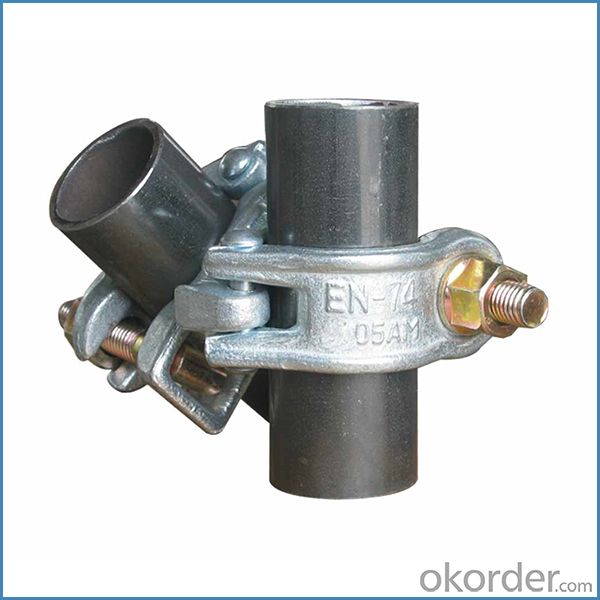
Feature
(1)Excellent Anti-Breaking—Cold Pressed Steel
(2)Outstanding Resistance Deformation
(3)Strong Anti-Dropping Ability
(4)Longtime USe
(5)Qualtity Guaranteed
(6)OEM Service
Photo
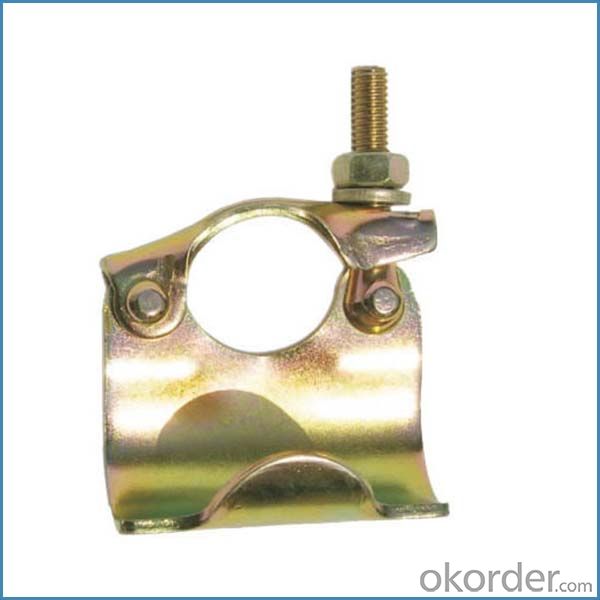
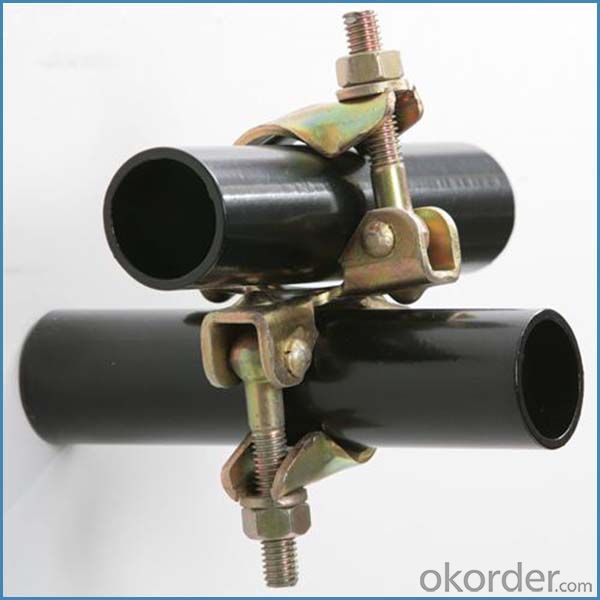
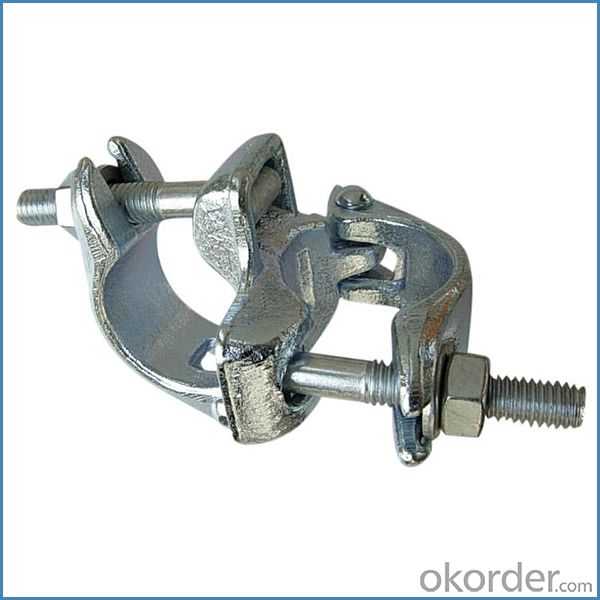
Parameter
| Material | Q235,345steel |
| Size | 48.3mm*48.3mm |
| Surface finish | Galvanized |
| Weight | 1.1kg around |
| Standard | BS1139,EN74 |
| Package | 25pcs/bag,steel pallet |
| Manufacture | As per customer requirement |
| Market | Africa, South America, the Middle East and Asia |
FAQ
Q: Are you a factory or trading company?
We are a state-owned corporation in China,dealing with various kinds of building materials.We have our holding subsidiaries.
Q: Where is your factory located? How can I visit there?
Our factory is located all around China.
Q: Can I get some samples?
Sample is free, customer only pay freight for the first time.
Q: Delivery?
10-30days. (5-15 containers)
Any question,feel free to contact us.
- Q: What are the common storage procedures for steel tube couplers?
- The common storage procedures for steel tube couplers include keeping them in a dry and well-ventilated area to prevent corrosion, organizing them in a way that avoids excessive weight or pressure on the couplers, and protecting them from direct sunlight or extreme temperatures to maintain their structural integrity. Additionally, it is important to store them in a clean environment free from dust, debris, and potential contaminants to ensure their proper functioning when used.
- Q: Are steel tube couplers compatible with different scaffolding tube materials?
- Different scaffolding tube materials are not compatible with steel tube couplers. Steel tube couplers are designed exclusively for use with steel scaffolding tubes and are specifically tailored to fit these tubes precisely. If steel tube couplers are used with materials like aluminum or plastic, it can result in instability, compromised safety, and potential failure of the scaffolding structure. To ensure a safe and secure construction environment, it is crucial to always verify that the couplers and scaffolding tubes are made of the same material and are compatible.
- Q: What are the potential drawbacks or limitations of using steel tube couplers in scaffolding?
- Some potential drawbacks or limitations of using steel tube couplers in scaffolding include: 1. Weight: Steel tube couplers can add significant weight to the overall scaffolding structure, making it more difficult to transport and set up. 2. Cost: Steel tube couplers can be expensive compared to other types of scaffolding connectors, increasing the overall cost of scaffolding projects. 3. Corrosion: Steel is susceptible to corrosion, especially in outdoor or humid environments. Regular maintenance and proper coating are necessary to prevent rust and ensure the longevity of the scaffolding structure. 4. Rigidity: Steel tube couplers can be rigid, limiting the flexibility and adaptability of the scaffolding system. This can be a drawback when working on uneven surfaces or complex structures. 5. Safety: If not properly installed or maintained, steel tube couplers may pose a safety risk. Structural failures, such as coupler slippage or detachment, can result in accidents or injuries. Overall, while steel tube couplers are widely used in scaffolding due to their strength and durability, it is important to consider these potential drawbacks and limitations before choosing them for a specific project. Alternatives like aluminum or plastic couplers may be more suitable in certain situations.
- Q: Can steel tube couplers be used for scaffolding projects on uneven or unstable ground?
- When working with scaffolding on uneven or unstable ground, it is crucial to take additional steps to ensure stability and safety. The integrity of the structure may be compromised due to the challenging ground conditions. To address this issue, several measures can be implemented. Firstly, it is important to thoroughly assess the ground conditions to determine the extent of the unevenness or instability. This assessment can be carried out by a qualified engineer or an experienced scaffolding professional. Based on the assessment, appropriate actions can be taken. These may involve the use of adjustable base plates or jacks to accommodate uneven ground. These devices allow for the leveling of the scaffolding and provide a stable foundation for the structure. Furthermore, it is essential to ensure that the scaffolding is properly braced and tied to adjacent structures or supports. This will enhance overall stability and prevent any potential movement or collapse. Regular inspections should also be conducted to monitor the condition of the scaffolding and make any necessary adjustments or repairs. This will guarantee that the scaffolding remains safe and stable throughout the project. In conclusion, while steel tube couplers can be utilized for scaffolding projects on uneven or unstable ground, it is vital to take extra precautions and implement measures to ensure stability and safety. A professional assessment of the ground conditions, the use of adjustable base plates or jacks, proper bracing and tying, and regular inspections are all crucial steps to mitigate risks and maintain a secure scaffolding structure.
- Q: Are steel tube couplers suitable for use in corrosive or chemical environments?
- Steel tube couplers are not appropriate for corrosive or chemical environments. When steel comes into contact with acids, bases, or saltwater, it is prone to corrosion. Over time, this corrosion weakens the steel, compromising its strength and structural integrity. To ensure safety and durability in corrosive or chemical environments, it is recommended to use couplers that are made from materials explicitly engineered to resist corrosion, such as stainless steel or plastic.
- Q: Can steel tube couplers be used in scaffolding projects with limited access to water sources for cleaning?
- Yes, steel tube couplers can be used in scaffolding projects with limited access to water sources for cleaning. Steel tube couplers are highly durable and resistant to corrosion, making them suitable for use in various environments, including those with limited water sources. Additionally, they can be cleaned using alternative methods such as dry brushing or using a solvent-based cleaner, ensuring that they remain free from debris and maintain their structural integrity.
- Q: Can steel tube couplers be used with other types of scaffolding couplers?
- No, steel tube couplers cannot be used with other types of scaffolding couplers.
- Q: What are the advantages of using steel tube couplers over other types of couplers?
- There are several advantages of using steel tube couplers over other types of couplers. Firstly, steel tube couplers offer superior strength and durability. Steel is known for its high tensile strength, which means that it can withstand heavy loads and forces without deforming or breaking. This makes steel tube couplers ideal for applications where structural integrity is paramount, such as in construction and engineering projects. Additionally, steel tube couplers provide exceptional resistance to corrosion. Steel has natural properties that make it highly resistant to rust and other forms of corrosion, ensuring that the couplers remain in good condition even in harsh environments. This makes steel tube couplers suitable for use in outdoor or marine applications, where exposure to moisture and other corrosive elements is common. Another advantage of steel tube couplers is their versatility. These couplers can be used with a wide range of tube sizes and materials, including steel, aluminum, and stainless steel. This flexibility allows for greater design possibilities and ease of installation, as they can be easily adapted to different tube dimensions. Moreover, steel tube couplers offer a secure and reliable connection. The design of these couplers ensures a tight fit between the tubes, providing a strong and stable connection. This is particularly important in applications where safety is crucial, such as in scaffolding or load-bearing structures. Lastly, steel tube couplers are cost-effective. While they may have a higher initial cost compared to other types of couplers, their long lifespan and low maintenance requirements make them a more economical choice in the long run. Additionally, their versatility and compatibility with various tube materials mean that they can be reused or repurposed for different projects, reducing the need for additional couplers. In conclusion, the advantages of using steel tube couplers include superior strength and durability, resistance to corrosion, versatility in tube sizes and materials, secure connection, and cost-effectiveness. These benefits make steel tube couplers a preferred choice for many industries and applications.
- Q: Are there any specific guidelines for the safe use of steel tube couplers in scaffolding near overhead cranes or lifting equipment?
- Yes, there are specific guidelines for the safe use of steel tube couplers in scaffolding near overhead cranes or lifting equipment. The guidelines aim to ensure the safety of workers and prevent accidents or damage to equipment. 1. Design and Calculation: The scaffolding design should consider the loads imposed by the overhead cranes or lifting equipment. This includes the weight of the equipment, the dynamic loads during operation, and any potential impact forces. The scaffolding should be designed and calculated by a competent person to ensure its stability and integrity. 2. Scaffolding Material: The steel tube couplers used in the scaffolding should be of high quality and suitable for the intended purpose. They should comply with relevant industry standards and have a sufficient load-bearing capacity to withstand the loads imposed by the overhead cranes or lifting equipment. 3. Inspection and Maintenance: Regular inspection and maintenance of the scaffolding and steel tube couplers are crucial to ensure their safe use. Any signs of damage, wear, or corrosion should be promptly addressed, and defective components should be replaced immediately. Regular inspections should be carried out by a competent person to detect any potential issues and ensure the structural integrity of the scaffolding. 4. Clearance and Separation: It is essential to maintain adequate clearance and separation between the scaffolding and the overhead cranes or lifting equipment. This prevents any interference or contact between the two, reducing the risk of accidents or damage. The specific clearance requirements may vary depending on the type of equipment and local regulations, but it is generally recommended to maintain a safe distance. 5. Communication and Coordination: Effective communication and coordination between the scaffolding team and the operators of the overhead cranes or lifting equipment are crucial for safe operations. Clear communication channels should be established, and both parties should be aware of each other's activities to avoid any conflicts or potential hazards. 6. Training and Competence: All personnel involved in the erection, modification, or dismantling of scaffolding near overhead cranes or lifting equipment should be adequately trained and competent. They should have a clear understanding of the specific safety guidelines and procedures to follow during these operations. Training should cover safe working practices, proper use of steel tube couplers, and emergency procedures. Following these specific guidelines for the safe use of steel tube couplers in scaffolding near overhead cranes or lifting equipment will help ensure the safety of workers and prevent accidents or damage to equipment. It is essential to comply with industry standards and local regulations and regularly review and update safety procedures as needed.
- Q: How do steel tube couplers compare to other types of scaffolding connectors in terms of ease of maintenance?
- Steel tube couplers are highly regarded in the market as one of the most durable and low-maintenance types of scaffolding connectors. Unlike wedge couplers or scaffold clamps, which require regular maintenance, steel tube couplers need minimal upkeep. One of the main benefits of steel tube couplers is their strong construction. These couplers are made from high-quality steel and designed to withstand heavy loads and harsh weather conditions, making them highly resistant to wear and tear. As a result, they can handle frequent use without requiring frequent maintenance. Furthermore, steel tube couplers have a simple and straightforward design, which makes them easy to maintain. Without any complex components or moving parts, there is less risk of them getting stuck or failing. This simplicity also means there are fewer parts that could potentially break or need regular inspection, reducing the need for constant maintenance. In addition, steel tube couplers are relatively simple to clean and inspect. A quick visual inspection can often reveal any signs of damage or wear, allowing for timely repairs or replacements. Cleaning can be done using common cleaning agents or by simply wiping away debris or dirt, ensuring the couplers remain in good condition. In conclusion, steel tube couplers offer a significant advantage in terms of ease of maintenance compared to other scaffolding connectors. Their durable construction, simple design, and easy cleaning make them a reliable and low-maintenance choice for scaffolding systems.
Send your message to us
Bs1139 Scaffolding Swivel Coupler British Type for Sale
- Loading Port:
- Tianjin
- Payment Terms:
- TT OR LC
- Min Order Qty:
- 100 kg
- Supply Capability:
- 100000 kg/month
OKorder Service Pledge
OKorder Financial Service
Similar products
Hot products
Hot Searches



